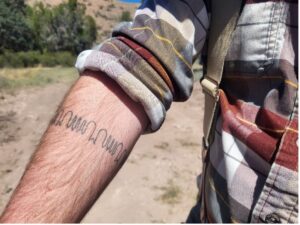
By Anne Dios, Wilderness Ranger
Fallen trees, or deadfall, on a trail have a way of slowing me down, and if the trail is not well worn, one fallen tree can be enough for me to stop and check the area, like a hound dog that lost a scent. A chainsaw seems like an obvious way to clear deadfall, and most of the time it is, but not in designated Wilderness. Of all the publicly owned land in New Mexico, only 2% is designated Wilderness, which is meant to protect it from our very human tendency to change it. Wilderness areas are maintained without the use of motorized equipment or mechanization, where people are ‘only visitors.’ We leave a lighter touch on Wilderness by using crosscut saws, powered by muscle, with no engine to scare off wildlife, and no exhaust to remind us of being stuck in traffic.

Before chainsaws were invented, and before the Wilderness Act of 1964, crosscut saws were used by loggers. Three makers, Disston, Atkins, and Simonds, were the major brands, crafting their saws with steel they made themselves. They competed to create saws for different purposes and created many different teeth designs. When the user (the sawyer) intends to cut -or fell- a standing tree they need a felling saw. When a sawyer needs to cut a tree that is already on the ground they need a bucking saw. What kind of tree is being cut, and if you have a partner helping you push and pull on one end or not, also influences what saw is ideal. Bucking saws are heavier, and a bucker 6′ long can weigh over 8 pounds.

The U.S. Forest Service helps maintain Wilderness and some National Forests have partnered with different non-profits or volunteers. If you ask them why, they might cite budget cuts; if you ask me, I think the more the public is engaged the better. Since 2016, anyone cutting trees within Wilderness must go through the same training to become either Class A, B, or C certified. Any sawyer within Wilderness must also be certified in First Aid and CPR, and these certifications need to be renewed every two or three years. NM Wild sawyers and volunteers leave more dangerous deadfall, like those trees dead and leaning over the trail, for those trained in felling.
A “Misery Whip” is what a saw might be called when it has not been sharpened properly. Forest Service partners and New Mexico Wild relies on professionals like Dolly Chapman, of www.sharpcrosscut.com, to help us keep our crosscut saws sharp. The complexity of sharpening these saws and the specific tools needed are highlighted in “The Crosscut Saw Filer” videos featuring Warren Miller. When you consider all the challenges that come with crosscut saws it might seem like the regulations are too restrictive. For many of those who work with crosscut saws, it is their preferred tool. I look forward to crossing paths with you in our stunning Wilderness, and maybe even with a crosscut saw hard at work.
About the Author

Anne chased coyotes and startled rattlesnakes in the chaparral of southern California as a child. During high school, she volunteered at an exotic animal shelter, and her desire to contribute to society led her to join the U.S. Army. After her deployment in the Middle East, she completed her B.S. in Environmental Studies. Anne hiked the Pacific Crest Trail in 2015 and the Continental Divide Trail in 2022. Hiking the length of New Mexico as part of the C.D.T., and seeing New Mexico’s unique beauty, she was compelled to move to Albuquerque. Inspired by her previous trail maintenance along the P.C.T. and her involvement with New Mexico Wild as a volunteer Wilderness Defender, she is thrilled to join NM Wild’s efforts as a Wilderness Ranger.

